-
Film Comments Selects And New Directors/New Films 2010
LINK INDEX FOR CK REVIEWS OF THESE TWO SERIES:
Amer (Hélène Cattani and Bruno Forzani 2009)--ND/NF
Be Wise (Juliette Garcias 2010)--FCS
Beautiful Darling (James Raisin 2010)--ND/NF
Bill Cunningham New York (Richard Press 2010)
Down Terrace (Ben Wheatley (2009)--ND/NF
Father of My Children, The (Mia Hansen-Løve 2009)-ND/NF
Green Zone (Paul Greengrass 2010)--FCS
How I Ended This Summer (Alexei Popogrebsky 2010)--ND/NF
Hunting & Sons (Sander Burger 2009)--ND/NF
I Killed My Mother (Xavier Dolan 2009)--ND.NF
Last Train Home (Lixin Fan 2009--ND/NF
Like You Know It All (Hong Sang-Soo 2009)--FCS
Man Next Door, The (Mariano Cohn, Gastón Duprat 2010)--ND/NF
Night Catches Us (Tanya Hamilton 2101)--ND/NF
Oath, The (Laura Poitras 2010)--ND/NF
Persecution (Patrice Chéreau 2009)--FCS
Red Chapel (Mads Brügger 2009)--ND.NF
Tehroun (Nader T. Homayroun 2009--ND/NF
The Film Society of Lincoln Center has three important film series at this time of year:
Film Comment Selects: February 19 – March 4, 2010
Rendez-Vous with French Cinema: March 11-21, 2010
New Directors/New Films: March 24–April 4, 2010
In this thread again this year I will be reporting on some selections from FCS and ND/NF.
I have reviewed all selections of the Rendez-Vous in another thread.
To go to the Forum comments thread for FCS and ND/NF 2010 go here.
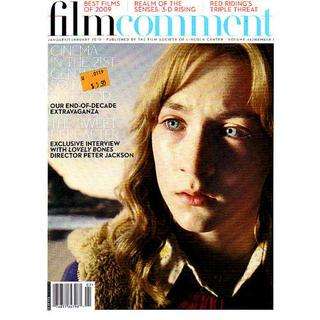
I've seen six of the Film Comment Selects series and will report on them briefly. The FSLC page for this series is here.
The FCS films I have watched are:
Persecution (Patrice Chéreau 2009)
Be Good/Sois sage (Juliette Garcias 2009)
Kinatay (Brillante Mendoza 2009)
Like You Know It All (Hong Sang-so 2009)
Happy End/Les derniers jours du monde (Armand and Jean-Marie Larrieu 2009)
The Time That Remains (Elia Suleiman 2009)
Green Zone (Paul Greengrass 2010)

I will attend some of the press screenings of New Directors/New Films and will report on them. They begin March 8, 2010. The list of films in the series and schedule of public screenings will be found here.
Last edited by Chris Knipp; 05-06-2010 at 12:42 AM.
-
Patrice Chéreau: Persecution (2009)--FCS
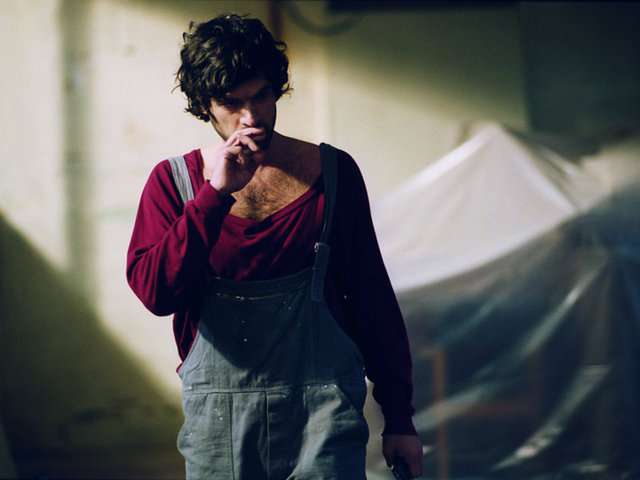
ROMAIN DURIS IN PERSECUTION. ANGST AT THE WORK SITE. BUT OVER WHAT?
(From the Film Comment Selects series.)
Talking and agonizing
Patraice Chéreau's disappointing new melodrama could be called Three Characters in Search of a Neurosis. Or perhaps the love-sick stalker played by Jean-Hugues Anglade has found his. Actually, though we don't know why, he's nuts; his character's name in the credits is simply "Le Fou," the crazy person. In a way Sonia's (Charlotte Gainsbourg's) character has found hers too: her neurosis is simply the protagonist, Daniel (Romain Duris). Trying to put up with Daniel's moods and pretending their relationship with such a self-absorbed drama queen has a future could be causing her to implode.
But what about Daniel? Daniel is a young man whose dramas have no discernible external motivation. He's disheveled in a fashionable, good-looking sort of way. He wanders between two construction sites, large rehab spaces actually, providing a spacious Parisian background for his rants, as well as a cool, if provisional, pad. As Daniel, Romain Duris does a lot of brow-wrinkling and complaining, as he does with more success in Dans Paris and The Beat My Heart Skipped, two other dramatic milestones for this actor that provided more of an objective correlative for his torments. But exactly what's bugging his character this time is not cleared up by the screenplay penned by Chéreau in collaboration with Anne-Louise Trividic (whom he worked with more successfully for his three previous films, Intimacy (2001), Son Frère (203), and Gabrielle (2005). All we know is that Daniel and Sonia are both emotionally drained and insecure.
The feel of the action is appropriately operatic (and its images handsomely chiaroscuro) for a director who's successfully staged so many actual operas, but these arias aren't worth listening to. Unfortunately Persecution illustrates too well the assertion of a friend of mine that French films consist of nothing but people talking. They talk about their relationship, they meet and part, meet again and talk some more, and they go to cafés and talk. There are some well-known actors in the café, with minor roles, including Gilles Cohen, Alex Descas, and Hiam Abbass. Some never get to say anything -- because the principals do so much talking, they're not needed, it would seem. Nothing much is happening except that Daniel feels he's not up to maintaining his relationship with Sonia. This is in spite of the fact that Sonia's work (whose nature is never specified) requires her to be frequently out of the country, and when she's back, they mostly just talk. This difficulty is compounded when "Le Fou" starts showing up with increasing frequency, doggedly pursuing (or persecuting?) Daniel and declaring his (mad) love, which nothing, even being beaten up by Daniel, can stop, and which nothing explains.
When Sonia's in town, Daniel is at her place two or three times a week, but always with the recriminations and suspicion on his part. And the narcissism, which is the less appealing since he appears to have no talent or consuming project to justify self-absorption. Eventually Sonia also begins to acknowledge that her relationship with Daniel is doomed. So you could also call this film The End of an Affair, or The Decline of a Relationship. Granted those titles are taken, or dull; Persecution piques the curiosity more, even if it's somewhat inaccurate, unless you conclude that the Crazy Person played by Anglade is "persecuting" Daniel by constantly turning up wherever he goes, even invading his temporary living space. But the Crazy Person seems more like a device than a person.
There is an irony about this emotionally unconvincing device of Le Fou, because Anglade's first lead role in a feature film was as the youth in Chéreau's haunting 1983 drama of sexual obsession, The Wounded Man/L'homme blessé. In L'homme blessé Anglade's character is a teenage boy still living with his parents who, impulsively running out to a nearby train station one night, for the first time acts upon powerful homosexual desires that lead him to pursue a dangerous older man. Here, he's the older man, but still doing the pursuing. Only this time the film doesn't get inside his psyche, and his obsession seems more like an annoyance (for its object) than a troubling and irresistible impulse.
Leslie Felperin points out in his Variety review of this film that Persection's theme mimics that of Ian McEwan's novel, Enduring Love, also made into a movie, of a man whose strained relationship with a woman becomes even more tormenting when he starts being stalked by a mad would-be male lover. The circumstances of meeting of the two men are shifted from a balloon accident to a meeting in a Metro station. However the Chéreau-Trividic writing team lack McEwan's knack for snappy plotting and Persecution never seems like it's going anywhere, and never really does.
Nothing can take away from the intensity of The Wounded Man, the dark beauty of La reine Margot, or the emotion of Those Who Love Me Can Take the Train or Son frère; and even if its audience has been limited, Gabrielle is a magnificent film. But despite some good moments and dedicated efforts from the actors, Chéreau is running on empty here. Maybe the gifted and charismatic Anglade, Duris, and Gainsbourg are exhausted too; maybe they should take a break from neurosis and go back to comedy for a bit.
Persécution opened December 9, 2009 in Paris with generally good, but some doubting, reviews (Allociné average score 2.0, points 51). Shown at the Walter Reade Theater, Lincoln Center, as part of the FSLC Film Comment Selects series in February 2010. You'll find more detail, and more sympathy, in Mike Goodridge's review in Screen Daily.
Last edited by Chris Knipp; 03-11-2010 at 03:18 PM.
-
Juliette Garcias: Be Wise (2010)--FCS
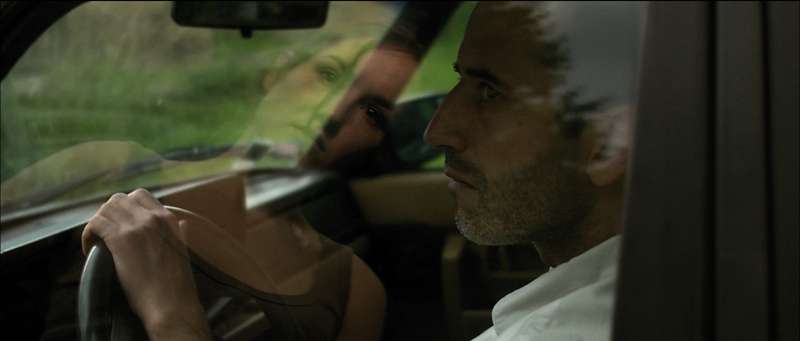
ANAIS DEMOUSTIER AND BRUNO TODESCHINI IN BE WISE
Juliette Garcias: Be Wise (2010)--FCS
Soft hints and portents
Shown as part of the Film Society of Lincoln Center Film Comment Selects, Be Wise/Soi sage maintains the series' reputation for blending elegance and edginess. Juliette Garcia's first feature, shown in February in FCS, scheduled for mid-April April release in France, is beautiful-looking, very quiet -- thoroughly weird. The fine camerawork is set off by silence, the rustle of trees, and piano passages. There's something hypnotic about the film and, eventually, disquieting.
The focus is on a rather distant young woman called Nathalie, who's taken a summer job at a remote village as a baker's delivery person. She tells everyone here her name is Eve, and for good reason. She doesn't want her presence yet to be known to Jean, a pianist and a married man with whom she has had an affair, who lives here.
A Zen-like calm pervades the early sequences of Be Wise/Sois sage. Natalie/Eve watches the young baker kneading bread. The camera seems to move silently through a green shade, like a stalker -- which is what Eve in a sense is. The quiet doesn't seem artificial. It fits with the stillness of a region that's warm and verdant but sparsely populated. Eve's job, which she plunges into without needing guidance, is to drive a small panel truck around the countryside delivering various-shaped loaves of the bakery's products to local households and collect money for them. The French dedication to making freshly baked artisanal bread available at all hours appears to be alive and well.
Anaïs Demoustier, the young but very assured actress who plays Nathalie/Eve, has the right kind of face, enigmatic, seeming to hide secret knowledge. She is both girlish and womanly. She lurks. She reveals nothing. She's friendly, but when approached, she pulls back. That goes for any men she encounters. She gives them a come-hither look, or even spends time with a young stranger by a river, but when approached, says she has a boyfriend. She keeps telling lies, which don't cohere, except to tell us that she's haunted. Sometimes we hear piano music. We get glimpses of Jean's life, and we see two sets of hands on a keyboard without knowing whose they are. Other characters emerge, people Eve gets to know doing her job.
That job seems to give her ready access to people's properties and houses. She walks up to them when they're asleep. She acquires an instant intimacy, without ceasing to be enigmatic. Without Jean's prior knowledge, even after he has run into her, she babysits his child. Already she has come to seem haunted and strange. It's never fully certain what the relationship was, but it appears to be something not at all normal. Garcias' style is extremely suspenseful, the mood verges on the horror genre, yet the effect is quite individual. Uncertainties that remain at the end seem quite calculated. This is a mood piece and a think piece that blends bizarre sexuality, obsession, and pastoral reverie. This is Fatal Attraction filtered through the sensibility of Catherine Breillat, done in a third style that we're now discovering.
Be Wise may not be for the general audience because it defeats genre expectations. Its slow, at times almost glacial, pace requires patience and won't work unless you give yourself up fully to the visuals. But these are lush. Indeed the film's beauty and self-assurance, despite its oddity, may point to US art house release. It's certainly an original and promising piece of work with a feminine point of view and it makes skillful use of image, ambient sound, and location to build its mood.
-
James Raisin: Beautiful Darling (2010)--ND/NF
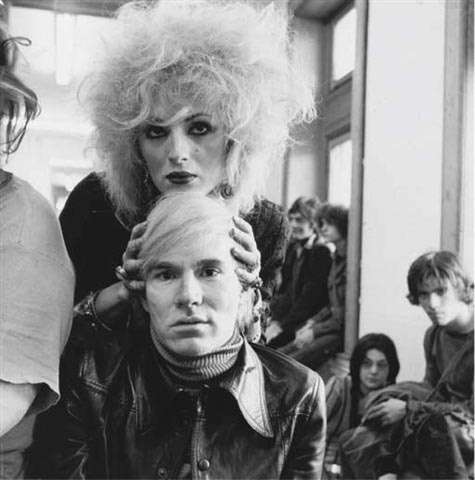
CANDY DARLING WITH ANDY WARHOL IN A VINTAGE PHOTO AT THE FACTORY
James Raisin: Beautiful Darling (2010)
Take a walk on the wild side
Edie Sedgwick, Andy's druggie socialite "muse," and a real girl, was dead by 1971. Among the "chicks with dicks" who gathered at the second, Union Square version of Andy Warhol's Factory, Candy Darling was the most ethereal and beautiful and pure, it seems from this documentary, which recounts her short life. She died of lymphatic cancer before reaching the age of thirty, already by then cast off by Andy, who used Holly Woodlawn and Jackie Curtis in later films. One of the many photographers who lensed her, Peter Hujar did a glamorous portrait of Candy on her hospital deathbed, garlanded with roses and still perfectly made up.
This documentary's existence is due to the devotion of Candy Darling's closest male friend, Jeremiah Newton, prominently featured and also a producer. He still carries the flame, and Beautiful Darling is book-ended by his arranging for Candy's ashes to be buried along with his (Jeremiah's) mother's, under a tombstone for them and, when his time comes, Jeremiah himself. Back in the day, he attached himself to Candy Darling when he was only sixteen and when she had a preferred place in Andy's Factory and the Factory hangout, Max's Kansas City.
Newton approached James Raisin (who's made films about the Beats and written stuff about Mapplethorpe and Patti Smith and a screenplay for Abel Ferrara about Warhol) with piles of memorabilia about Candy and interview tapes he made right after her death with people who knew her. He also had archival film footage. Raisin has woven together all these records and his own recent interviews with some germane and often pungent talking heads, including Fran Lebowitz, Glenn O'Brien, Taylor Mead, Bob Colacello, John Waters, Gerald Malanga, Paul Morrissey, Holly Woodlawn, Pat Hackett, George Abagnalo, and Sam Green, among others, to make Beautiful Darling an excellent record of the person and the context and another valid entry in the collection of cinematic Warholobilia. There is lots of good and appropriate music, and for readings of letters and statements, Chloe Sevigny does the voice of Candy Darling.
She was originally Jimmy or James Slattery, and as we're told in Lou Reed's famous song "Walk on the Wild Side," which describes the "chick with dicks" Andy used and threw away, "Candy came from out on the Island," Long Island, that is, from a flat monotonous development in Forest Hills. Candy came from out on the Island/In the backroom she was everybody's darlin'/But she never lost her head/Even when she was giving head/She says, Hey babe/Take a walk on the wild side/I Said, Hey baby/Take a walk on the wild side/And the coloured girls go/Doo do doo do doo do do doo...'
While Edie Sedgwick was born a real girl, Holly Woodlawn, Candy Darling, and Jackie Curtis were among the various trannies who gathered at the Factory. 'Take a walk on the wild side' was a come-on to prospective johns, meaning, Have sex with a transvestite prostitute. But what we learn from Beautiful Darling is that the Warhol Factory girls weren't all alike.
None of them worked harder at being a girl than Candy, but not just at being a girl -- at being glamorous and beautiful, inspired by memories of Forties screen divas seen in TV movies and dreams of Hollywood fame. She didn't always necessarily say much, except when performing somebody's lines, always in that special breathy feminine voice of the drag queen (or Marilyn). She was in Warhol's Flesh and Women in Revolt. Candy used her Warhol film fame to land other screen appearances, and Tennessee Williams, who was among her admirers, cast her in his play, Small Craft Warnings.
Warhol, in one of the clips, says he was making movies because it was easier than painting. Cross dressing, though, was not only hard work but dangerous work: back in the Sixties it was illegal in New York for a man to be on the street dressed as a woman. They could be hauled off by the cops just for wearing heavy mascara, so the trannies carried their dresses in shopping bags and slipped their gear on slowly till night came, and it was safer. (Agosto Machado tells us about this.)
Beautiful Darling shows us hints of Candy's Jimmy Slattery origins, including a still of the then boy of 14 or so stretched on a chaise longue in shorts, showing long, sleek ivory gams. It's strange to see Jeremiah, who like not a few of the former Warhol beauties, is a big limping blob of a person now, as a wraith-like androgynous beauty himself, when with Candy. But in a self-penned obit, Candy mentions poor Jeremiah way down in her list of people she loved and owed it all to.
John Waters is always a sharp voice, but Fran Lebowitz, one of the wittiest and most articulate non-writing writers of our times (and of course author of the droll Metropolitan Life, first aired as columns for Andy's Interview magazine), is the treasure here. Not just she but Andy himself says Candy should not lose the penis. She just wouldn't be the same. Apparently she and Newton were not a couple and she had no man in her life. The film ends with the line that to be true to yourself is the greatest morality. But as Lebowitz points out, a transsexual who becomes female never had a girlhood. And so Candy, though wonderfully successful at being a glamorous mirage, found it terribly hard work. Fran points out real women don't work so hard all the time. And so it is artificial, and exhausting, and Candy was ready to die of cancer. When the tumor was found, it ushered in one of her greatest roles, that of a tragic early death.
Beautiful Darling had its world premiere at the Berlinale in February 2010, showed at the BFI Lesbian and Gay Film Festival in London in March, and will be presented as part of the New Directors/New Films series of the Film Society of Lincoln Center and the Museum of Modern Art, April 2, 2010 at MoMA and April 3 at the Walter Reade Theater.
Last edited by Chris Knipp; 03-10-2010 at 07:10 AM.
-
Hélène Cattet and Bruno Forzani: Amer (2009) --ND/NF
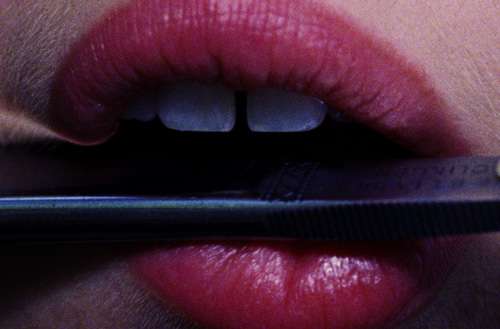
Hélène Cattet and Bruno Forzani: Amer (2009)
Images and sound
Cattet and Forani are a Belgian couple who have made five short films together. This is their first feature. Divided into three parts, it focuses on childhood, adolescence, and womanhood in the life of Ana. Each moment is seen symbolically, very sensually, but without much discernible narrative, in a marvelous display of stylized visuals (in intensely colored and multiple-filtered 35 mm. images). There is a powerful, hit-you-over-the-head soundtrack. The material is fragmented, beginning with the images of eyes, presented in long horizontal rectangles. A girl is browbeaten by parents, or a couple anyway, whom she witnesses through a keyhole, shut in, and comes upon having sex. Later she also contemplates the hardening corpse of her dead grandfather. White grains under a bed. An ant. A spider. Loud booming sounds, which unfortunately in the Museum of Modern Art screening room blended with the underground sound of a rumbling subway line.
Later, the girl grows up and the film, which begins with dark interiors in an old house, switches to a sunny, Mediterranean, outdoor world. We are near Menton (credits indicate later), on the margin between the French and Italian Rivieras, along the Cote d'Azûr or the Amalfi Drive. A gang of motorcyclists with leather and metal and tight jeans stand by the road with their cycles. But we see only bits and pieces of them.
And this goes on and on, never ceasing to be beautiful, lushly noisy, sensual, fragmented, narrative-free. Amer, which means "bitter" in French, may be ideal for those who like to revel in "pure cinema."
There is one trouble though, and that this film tends to turn neurosis -- or desire, whatever it's about, which isn't altogether clear to me -- into a fashion shoot. It's said to mimic the style of Italian "giallo," pulp fiction, or the Daria Argento kind of stuff, and Italian movie music is among the many sonic allusions. Initially the feel is very much like something Spanish, or the Guillermo del Toro of Pan's Labyrinth. But as time goes on the impression of a fashion shoot undercuts the evocation of dream and fantasy through visual means. What might have been edgy, subtle, and memorable turns to chic kitsch. Or slick horror, when someone plays around with a straight razor in a threatening and suggestive manner as in Dali-Buñuel's Andalusion Dog.
While I and others with me found Amer hard going, despite its accomplished visuals, a British online reviewer called Alan Jones (reporting on the London Film4 Frightfest) was entranced, delighted with the evocation of Italian "gialli." He concludes, speaking of the late segment he explains is a walk along the highway to the hairdresser: "Charlotte Eugene-Guibbaud couldn’t be more tantalizing as the hair-chewing Lolita either with her mini-dress hem flapping against her knickers at crotch-level. Maria Bos is pure Florinda Bolkan in the eyes-reflected-in-knife-blade finale, the portion where debts to A LIZARD IN A WOMAN’S SKIN are felt the most. Shimmering with a lush vibrancy and utilizing recycled Ennio Morricone, Bruno Nicolai, Stelvio Cipriani and Adriano Celentano music within its superb sound design, AMER carries an erotic and exotic charge I never thought could be replicated again outside such essential gialli as STRIP NUDE FOR YOUR KILLER or the classic Dario Argento Animal Trilogy. AMER is a faultless masterpiece, so just relax and breathe in the heady perfume of Cattet and Forzani’s dazzling lady in black."
This glowing report shows the potential Amer has as a festival film that may, since Magnolia has bought it, get theatrical attention. However, in my view Cattet and Forani have not essentially moved up from their five short films to a feature, because this is merely short-film material spread out over ninety minutes, divided into three, and diced up into many edited visual fragments. A series of stylish pastiches does not a feature make. The conception is too slight and too fragmented to work as a real feature film. Nice eye candy though, and as Jones says, the sound design also is definitely "lush."
Shown as part of the New Directors/New Films series co-sponsored this year by MoMA and the Film Society of Lincoln Center and sown in New York at both the Walter Reade Theater and MoMA's Titus Theater in April 2010. Amer has been shown at many festivals between September 2009 and spring 2010.
Last edited by Chris Knipp; 03-11-2010 at 03:36 PM.
-
Sander Burger: Hunting & Co. (2010)--ND/NF

Sander Burger: Hunting & Co. (2010)
Modern marital meltdown
In this Dutch film, the director's second feature, Burger and his collaborators on the screenplay, Dragon Bakema and Maria Kraakmank (who also play the two main characters, Tako and Sandra) have devised a chilling and powerfully disturbing study of the meltdown of a marriage. Tako's father has died, prompting him to move from the big city back to the small town of Den Oever and take over his father's bike shop. His mother moves to a retirement community, and Tako and Sandra move into the apartment above the shop.
In their synopsis for the press kit, the filmmakers write, "Tako and Sandra really shouldn't have married in the first place. The only things they have in common are superficialities and material happiness. The interior of their house, made up of furniture and trinkets from IKEA and Habitat catalogues, is a reflection of their passionless relationship. They both work hard -- Sandra at an employment agency and Tako at the bike shop -- yet there is hardly any communication between them."
This partial description shows both the strength and the weakness of Hunting & Sons/Hunting & Zn. The film makers treat their young couple, whose marriage we witness, like insect specimens on a tray. It's good that the trajectory is quite clear, and that doesn't make watching what happens any less surprising and disturbing. Though the outcome, in the manner of classical tragedy, is inevitable, its specifics are not the less surprising and disturbing.
Perhaps here the doom is sociological and psychological. It is also a mystery. Or, to go on with the insect metaphor, it is like the image in King Lear: "As flies to wanton boys are we to th' gods, /They kill us for their sport." For us, Tako and Sandra are brittle creatures. The go back and forth from work to house, blithely greeting each other with comically jaunty "Hi's" and "Hey's. And they indeed have little else to say with each other.
The are people, though, and when, as the synopsis goes on, "problems worsen as Sandra gets pregnant," we are not looking down from above but watching Tako disintegrate as he tries all the wrong things to remedy the main problem -- that his wife turns out to have an eating disorder and keeps passing out. What may have worked for her as a life stile before without attracting attention, no longer does with another being growing inside her. After her first passing out in the bathroom, which causes Tako to panic and call an ambulance, tests show that Sandra and the baby are okay. But she is, the doctor tells Tako, dangerously thin -- and as we see in separate scenes, she turns out to be much more into working out at the rowing machine of her gym than taking nourishment, even now.
Burger is skillful at throwing down hints at first and later at letting the devolution of the relationship slowly unfold. In an early scene, Sandra freaks out when a pair of jeans shows the crease of her undies in back: too tight! That has significance later, of course. When she first throws up, it's from the pregnancy. There's something disquieting, though, the way she covers her mouth and takes away the covers of the bed she's soiled, as if to hide the signs of her indiscretion. Later, she will throw up again, and not because of her pregnancy.
What happens is ugly, and we can't describe it. Burger is skillful also at showing the separateness of the couple. Rarely has a pair of young people seemed so disquietingly in their own windowless worlds, never more than when Tako takes his drastic measures, and the film cuts back and forth in classic suspense-generating thriller fashion between the two people.
There was something wrong with Sandra, doubtless an insecurity no one noticed before. But now, Tako is the one who completely loses his hold on everyday reality. There is excellent control of process here and throughout the film, which moves from joy to panic: at first, so much "happiness," and so much emptiness. And so many images that become haunting later -- such as Sandra, caught turning toward Tako when he opens the bathroom door, wrapped in a towel, her face masked in white cream, peering out at him surprised like an owl -- or a ghoul.
Another element is the bike shop worker, Patrick (Noël Keulen), and the couple's two mothers, whose reactions ironically contrast with their children's. Sandra's mother is warm and joyful; Tako's unresponsive. Ironically too, Tako's mother is stingy with food, while he is a chunky fellow who likes his pasta and beer.
The elements are simple here, but it's a sign of the filmmaker's fine control of the material that the marriage meltdown becomes a horror show from which you can't look away, much as you might like to. This is strong and memorable stuff. But the weakness for us as modern observers is that we don't accept the strict determinism of the writers' conception. How do we know that IKEA furniture means a couple is superficial? Do their happy greetings and small conversation really mean they have no love, no depth in their relationship? How do we know their marriage was doomed from the start? And if it was, isn't this drama, for all its messy thriller feel, just a little too tidy?
Hunting & Zn was introduced in the Rotterdam Film Festival early this year. Shown as part of the New Directors/New Films series at the Walter Reade Theater and MoMa, in New York City, April 2010.
Last edited by Chris Knipp; 08-06-2014 at 01:11 PM.
 Posting Permissions
Posting Permissions
- You may not post new threads
- You may not post replies
- You may not post attachments
- You may not edit your posts
-
Forum Rules






 Reply With Quote
Reply With Quote





Bookmarks